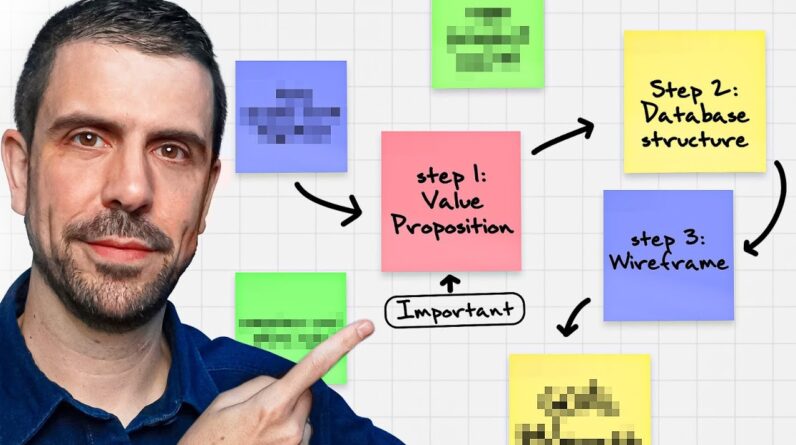
Planning your app effectively is crucial to turning your million-dollar idea into reality. A staggering 90% of apps fail due to lack of proper planning, so focusing on the right steps will significantly increase your chances of success. This article breaks down a proven three-step process that can be accomplished in just 30 minutes using a single AI tool.
Explore key actions like customer discovery and validation, where you engage with potential users to refine your concept. Additionally, discover how to leverage visual planning tools to create mind maps, flowcharts, and wireframes that streamline development and enhance collaboration with your team. Save time and effort by integrating these methods into your app creation journey.
Table of Contents
Understanding the App Development Landscape
Current Trends in App Development
In recent years, the app development landscape has been rapidly evolving. You’ll notice that trends such as no-code development and low-code platforms are gaining traction. These solutions empower non-technical users to create applications without needing extensive programming knowledge. Additionally, the integration of artificial intelligence (AI) and machine learning (ML) into app functionality has become a significant selling point. Apps are becoming smarter and more intuitive, catering to the unique needs of their users. The focus has shifted toward personalization, with user experience (UX) at the forefront of app design. Furthermore, the rise of 5G technology is paving the way for apps to deliver higher quality streams and faster load times, making user engagement a more seamless experience.
Statistics on App Success and Failure
When it comes to app success rates, the numbers can be daunting. Statistics reveal that nearly 90% of apps fail to achieve their goals after launch. This high rate of failure often stems from insufficient user research and a lack of proper planning. Conversely, successful apps often rely on effective market research, user engagement, and marketing strategies. A well-executed app can make it to the top charts of app stores, with the potential to generate significant revenue. According to some reports, only 22% of apps are considered successful, meaning they can maintain a substantial user base and generate profits. Understanding these statistics can help you navigate the complexities of app development and guide your approach.
Market Demands and Shifts in User Behavior
As you embark on your app development journey, it’s essential to keep an eye on market demands and shifts in user behavior. Today’s users are more accustomed to seamless app experiences and expect personalization at every turn. There is a growing demand for apps that integrate social sharing features, gamification, and augmented reality (AR). Users are also becoming increasingly privacy-conscious, prompting a demand for apps that prioritize data security. You must adapt to these trends, keeping user preferences in mind, to enhance user engagement and retention.
Importance of Proper Planning
Statistics on App Failures Due to Lack of Planning
Planning is a crucial step that is often overlooked by aspiring app developers. Studies show that a staggering 90% of app failures can be attributed to a lack of planning. Whether it’s market research, user experience considerations, or budgeting, inadequate planning leads to products that miss the mark. To change the narrative surrounding app success, embracing a well-structured planning phase is essential.
Why Planning is Crucial for Profitability
Proper planning isn’t just about laying out a roadmap; it’s a catalyst for profitability. When you take the time to detail your app’s functionality, marketing strategy, and target audience, you can allocate resources more effectively, reducing costly mistakes down the line. An app that meets the user’s needs and expectations tends to yield higher retention rates, ultimately translating into profitability. Effective planning can lead to informed decisions regarding monetization strategies, marketing approaches, and feature prioritization.
Elements of Effective App Planning
As you navigate the app planning process, it’s important to incorporate specific elements to enhance effectiveness. Start by defining your app’s unique value proposition (UVP): what sets it apart in the crowded app market? Conduct thorough market research to understand your competitors and potential users. Create user personas that capture the characteristics and preferences of your target audience, guiding your design and functionality choices. Craft a detailed project timeline that includes milestones and key deliverables to keep your team aligned. Lastly, ensure that you gather stakeholder input during the planning phase to incorporate diverse perspectives and insights.
Customer Discovery & Validation
Conducting Customer Interviews
To ensure your app aligns with user needs, you should begin by conducting customer interviews. These interviews will provide you with first-hand insights into user preferences, pain points, and behaviors. By directly engaging with potential users, you can validate your app idea and identify any necessary adjustments early in the process. Keep the conversation focused on understanding their experiences and expectations regarding similar apps.
Validating App Ideas Through Surveys
Alongside face-to-face interviews, using surveys is an effective way to collect quantitative data to validate your app idea. Distributing a well-structured survey across platforms can help gauge interest and gather feedback from a broader audience. Focus on specific aspects of your app, such as desired functionality, pricing models, and user experiences. This data will help you make informed decisions on whether to move forward with your project or refine your idea.
Methods for Gathering Feedback and Iterating
Feedback gathering continues beyond the initial stages of planning. Developing prototypes and beta versions of your app can facilitate ongoing user feedback. Consider utilizing tools that allow you to gather user insights as they interact with your app. This iterative process helps you measure user engagement and satisfaction, allowing you to refine features and design before the official launch. Keep in mind that user feedback is invaluable, paving the way for success.
Leveraging AI in Planning
Introduction to AI Tools for Planning
As technology continues to evolve, integrating AI tools into your planning process can significantly enhance efficiency. These tools streamline various aspects of app development, from generating ideas to creating visual representations of your app. Artificial intelligence can help analyze user behavior, content, and data patterns, providing actionable insights that inform your planning.
Benefits of Using Meo for App Development
Meo is a robust visual planning and collaboration tool designed with app developers in mind. This AI-powered platform transforms the complex planning process into a collaborative experience where team members can brainstorm, design, and iterate ideas together. By leveraging Meo, you can engage with your team in real-time, facilitating better communication and fostering creativity. The AI features within Meo allow for a more efficient planning experience by automating parts of the process.
Streamlining Brainstorming and Planning Processes
Brainstorming can often become chaotic, particularly when multiple team members are involved. Meo’s intelligent canvas enables your team to brainstorm ideas seamlessly, organizing thoughts and concepts into visual formats. By using AI to categorize and prioritize ideas, your planning process becomes more structured and effective. You’ll find that this streamlining leads to better clarity and organization, setting a strong foundation for your app development journey.
Creating a Mind Map and Flowchart
Definition and Purpose of Mind Maps in App Development
Mind maps are visual tools that allow you that map out ideas logically and cohesively, breaking down complex projects into manageable parts. They serve as a roadmap for your app’s features and functionalities while clarifying the relationship between different components. Using mind maps can help you visualize your app’s overall structure, making it easier to identify essential elements during the development process.

How to Create an Effective Flowchart
Flowcharts act as a visual representation of your app’s user journey, illustrating how users will navigate through the app from start to finish. To create an effective flowchart, begin by outlining the key steps users will take while interacting with your app. Use clear symbols and arrows to indicate flow direction, ensuring that even stakeholders outside your development team can understand the process. These flowcharts will help your team streamline production and provide clarity throughout development.
Case Study: Designing a Hiring Platform with AI Integration
Let’s consider a case study of designing a hiring platform that leverages AI for optimal results. A well-structured mind map starts with the core functionality, such as uploading resumes and linking job postings. From there, sub-features like AI-driven resume analysis and feedback loops are identified. Creating a flowchart, you would depict the user experience, starting from how a job seeker uploads their resume to how the AI analyzes it and provides recommendations. This structured documentation ensures you’ll have a roadmap to reference throughout the development process.
Structuring Your Database
Importance of Database Structure for App Functionality
The backbone of any successful app lies in its database structure. An effectively structured database ensures efficient data management and retrieval, directly impacting your app’s performance. Poor database organization can lead to slow load times, bugs, and ultimately, a frustrating user experience. By prioritizing database structure, you’re ensuring your app functions optimally, supporting its overall capability.
Using AI to Define Database Requirements
Integrating AI into your database structuring process can help you identify and define the necessary requirements more quickly. AI tools can analyze your app’s projected functionality and recommend optimal database architectures. This allows you to anticipate and solve potential issues before they arise, saving you valuable time and resources.
Examples of Common Database Structures in Apps
Common database structures, such as relational databases, key-value stores, and document-oriented databases, serve different purposes depending on your app’s needs. For instance, a relational database is ideal for structured data, whereas a key-value store works well for real-time applications. Familiarizing yourself with these structures will help you make informed decisions about which one best suits your app’s goals.
Developing Wireframes
Purpose of Wireframes in App Design
Wireframes are essential blueprints for your app’s user interface (UI). They offer a visual representation of the layout, key screens, and functional elements you plan to include. Wireframes allow you to determine user flow and ensure a cohesive user experience before diving into the actual design work. They serve as a foundation for your development, guiding your team in visualizing how your app will look and function.
Tools for Creating Wireframes
Numerous tools are available to help you create wireframes effectively. Platforms like Figma, Sketch, and Adobe XD allow you to design wireframes with ease and flexibility. You can collaborate with your team in real-time, making changes and updates as needed. Whichever tool you choose, prioritizing user experience in these wireframes will ensure smooth development.
Facilitating Team Collaboration Through Wireframe Feedback
Wireframes are not only a design tool but also a communication tool among team members. Sharing wireframes within your team encourages constructive feedback, ensuring that the design aligns with your vision. By involving stakeholders and potential users in the feedback process, you can refine wireframes based on real user preferences. This collaborative approach leads to a more polished final product that resonates with your target audience.
Integration and Project Collaboration
Benefits of Using Collaboration Tools Like Jira and Slack
Integrating collaboration tools like Jira and Slack into your project management workflow promotes effective communication among team members. Jira assists with tracking tasks, managing project timelines, and monitoring progress, while Slack serves as a real-time communication platform. These tools streamline collaboration, enabling your team to stay organized and connected, ultimately improving overall project efficiency.
Best Practices for Team Communication
Establishing best practices for team communication can greatly enhance your app development process. Encourage an open feedback culture where team members feel comfortable sharing ideas and concerns. Schedule regular check-ins to discuss progress, evaluate challenges, and make necessary adjustments. Moreover, documenting communication can serve as a valuable reference for future phases of the project.
Integrating Project Management Tools for Smoother Workflows
In addition to Jira and Slack, consider incorporating additional project management tools such as Trello or Asana to enhance workflow organization. Integrating various tools ensures that everyone has clear visibility on tasks, deadlines, and collaborations. This structured approach allows for smoother transitions between project phases and keeps everyone accountable.
Time Management in App Development
Strategies for Efficient Use of Time During Development
Managing your time during app development requires strategic planning and prioritization. Set clear milestones and deadlines for each phase, enabling your team to stay focused on delivering results on time. Furthermore, you can adopt agile methodologies, allowing for flexibility as priorities shift. By regularly assessing progress, you can allocate resources where they are most needed.
How Planning Saves Time and Resources
Proper planning saves not only time but also resources in the long run. By mapping out workflows, identifying potential bottlenecks, and understanding user needs, you can avoid unnecessary delays. The time invested in detailed planning will pay off, minimizing the likelihood of costly revisions and setbacks later in the development process.
Dividing Tasks for Team Efficiency
Effective task division is key to maximizing team efficiency. By assigning roles based on each team member’s strengths and expertise, you can ensure that tasks are executed effectively. Utilize methodologies such as Kanban or Scrum to facilitate efficient task management, allowing your team to work collaboratively while remaining on track.
Conclusion
Recap of Key Points from the Article
To recap, navigating the app development landscape involves understanding current trends, market demands, and the importance of proper planning. Conducting customer discovery through interviews and surveys allows for effective validation of your ideas, while leveraging AI tools like Meo can significantly enhance your planning process. Creating mind maps and flowcharts clarifies your app’s structure, and establishing efficient database designs and wireframes ultimately lays the groundwork for a successful app.
The Importance of Planning in Achieving App Success
Planning is vital in setting the stage for app success. A structured approach not only decreases the likelihood of failure but also significantly enhances your app’s potential for profitability. Embracing a well-organized planning phase ensures that your app resonates with users and meets their needs effectively.
Encouragement to Explore Tools and Resources for App Development
With all these insights in mind, you are encouraged to explore the plethora of tools and resources available for app development. Whether it’s planning tools, wireframing software, or collaboration platforms, each plays a role in streamlining your development journey. Embrace these resources, keep user needs at the forefront, and pave the way for your app’s success!







